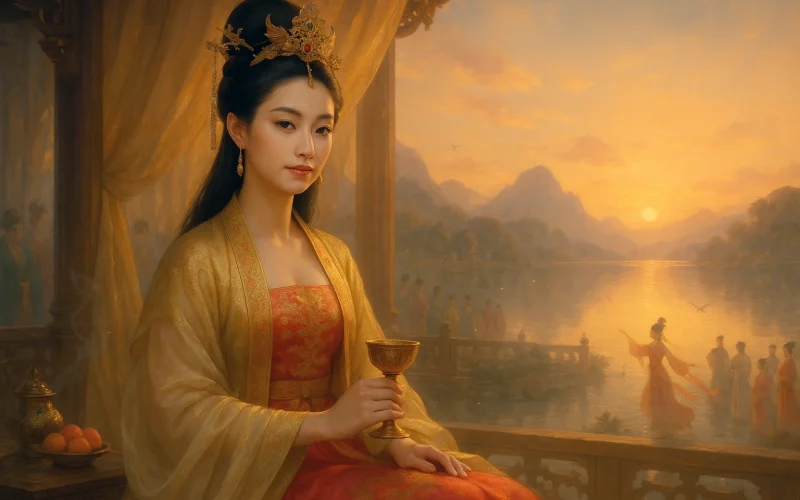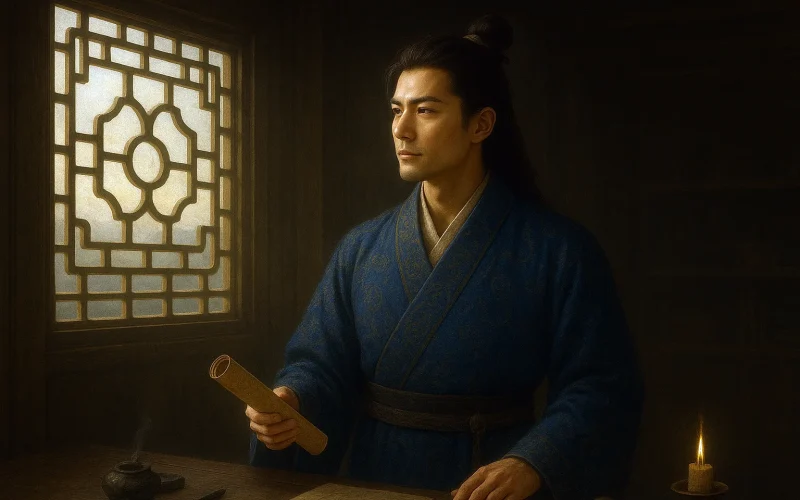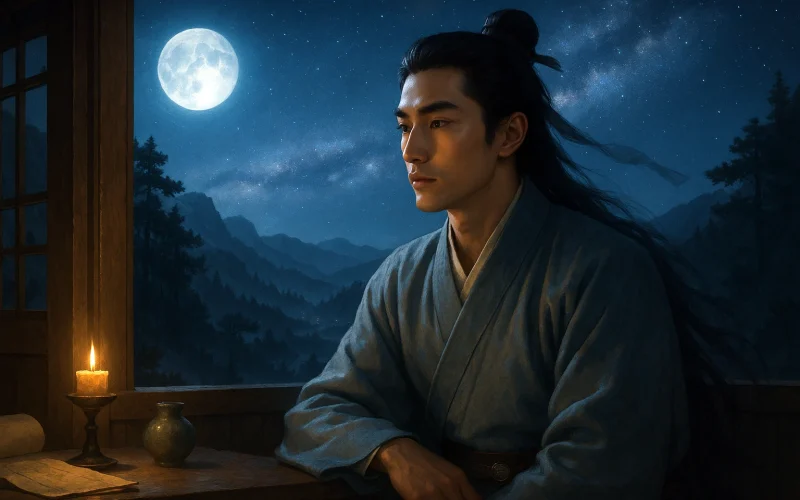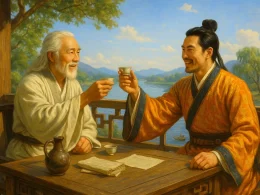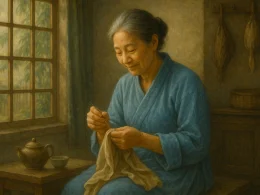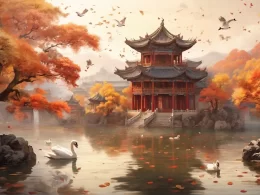The imperial princess loves a fairy queen;
Her villa’s newly built by clouds serene.
The hills resemble the Phoenix Singing Hill;
The lake surpasses the Dragon Drinking Rill.
Her green-curtained bower keeps spring long;
Her gold-knocked hall seems with sun hung.
Obedient, I come with the imperial cab;
We toast longevity with music glad.
Original Poem
「侍宴安乐公主新宅应制」
沈佺期
皇家贵主好神仙,别业初开云汉边。
山出尽如鸣凤岭,池成不让饮龙川。
妆楼翠幌教春住,舞阁金铺借日悬。
敬从乘舆来此地,称觞献寿乐钧天。
Interpretation
This poem was composed during the Jinglong era of Emperor Zhongzong of Tang, when Princess Anle had newly built a mansion, and the imperial court held grand banquets, commanding officials to write poems in celebration. Shen Quanqi, then serving as Zhongshu Sheren (a mid-level central government official), composed this poem by imperial order. Princess Anle was known for her extravagance and influential power, and her palace grounds were lavishly decorated. As a courtier attending the banquet, the poet was required to focus on praising the emperor and the nobility, resulting in a style that is grand, elegant, and richly ornate, typical of Shen Quanqi's early occasional works. It also reflects his political circumstances and poetic tendencies while serving close to the powerful elite.
First Couplet: "皇家贵主好神仙,别业初开云汉边。"
Huángjiā guì zhǔ hào shénxiān, biéyè chū kāi yúnhàn biān.
The imperial princess adores a celestial life;
Her new estate opens by the side of the Milky Way.
The opening couplet uses celestial imagery to convey utmost reverence. "Adores a celestial life" compares the princess's luxurious lifestyle to a transcendent fairy realm, while "by the side of the Milky Way" suggests the estate's lofty grandeur, rivaling the heavens. This grandiose opening follows the conventional ornate and respectful tone of court poetry, setting a noble tone for the subsequent descriptions.
Second Couplet: "山出尽如鸣凤岭,池成不让饮龙川。"
Shān chū jìn rú míng fèng lǐng, chí chéng bù ràng yǐn lóng chuān.
The man-made mountains resemble the legendary Singing Phoenix Ridge;
The ponds rival the ancient Drinking Dragon River.
This couplet employs allusions to ancient place names to highlight the estate's magnificence and mystical quality. "Singing Phoenix Ridge" and "Drinking Dragon River" originate from Zhou Dynasty myths, where phoenixes and dragons symbolize imperial power and auspiciousness. By comparing the princess's estate to these, Shen Quanqi emphasizes its luxury and the nobility of the royal bloodline. However, while the metaphors are skillful, they can feel somewhat rigid. Later critics often noted that this couplet "prioritizes ornamentation over genuine feeling," reflecting the limitations of occasional poetry's pursuit of rhetorical flourish.
Third Couplet: "妆楼翠幌教春住,舞阁金铺借日悬。"
Zhuāng lóu cuì huǎng jiào chūn zhù, wǔ gé jīn pū jiè rì xuán.
The dressing tower's green curtains seem to hold spring within;
The dance pavilion's golden mats borrow sunlight to hang aloft.
This couplet is the most vivid and expressive. "Green curtains" symbolize the dressing tower's grace and opulence, while "golden mats" depict the dance pavilion's radiant brilliance. The poet skillfully uses dynamic metaphors—"hold spring within" and "borrow sunlight to hang aloft"—to imbue static architecture with life, creating a bright and lively scene. Rich in imagery and clear in composition, this couplet represents the poem's artistic peak and best showcases Shen Quanqi's talent and diction.
Fourth Couplet: "敬从乘舆来此地,称觞献寿乐钧天。"
Jìng cóng shèng yú lái cǐ dì, chēng shāng xiàn shòu yuè jūn tiān.
Respectfully following the imperial carriage to this place,
We raise cups to offer longevity toasts, with music akin to celestial harmonies.
The final couplet clarifies the "banquet attendance" theme. "Respectfully following" and "raise cups" express the courtier's deference, while "celestial harmonies" describe the music's beauty, providing a natural conclusion. This not only serves as a standard ending for occasional poetry but also praises the imperial ceremony, reflecting the poet's submissive stance within the power structure.
Holistic Appreciation
The entire poem uses ornate diction and a solemn, elegant rhythm to depict the splendor of Princess Anle's new estate and the grandeur of the banquet. From the "Milky Way" and "Singing Phoenix Ridge" to "green curtains," "golden mats," and "celestial harmonies," the descriptions progress layer by layer, forming a magnificent and vibrant portrait of the palace grounds. The poet uses the scenery to offer praise, with refined language and strict meter, demonstrating Shen Quanqi's artistic consciousness during the formative period of regulated verse. However, despite its brilliant diction, the poem lacks emotional depth, functioning more as an "occasional masterpiece," reflecting the surface prosperity and inner emptiness of early Tang court poetry. Later critics described it as "skillful but lacking genuine feeling," yet from a literary history perspective, it signifies the normative beauty of regulated verse's maturation.
Artistic Merits
- Elaborate Descriptions and Precise Parallelism: Exemplifies the typical court panegyric style with exquisitely refined and sumptuous phrasing.
- Skillful Use of Classical Allusions: Employs ancient place names like "singing phoenix" and "water-drinking dragon" to symbolize auspicious signs, using historical references to honor the sovereign.
- Progressive Layering of Imagery: Composition unfolds from distant to near views, transitioning from scenery to human elements, creating rich visual tapestry.
- Decorative Linguistic Style: Frequent use of chromatic and luminous imagery constructs a magnificent and luxurious atmosphere.
- Distinct Occasional Context: The entire poem's conception centers on "dedication" and "praise," demonstrating both the subject's reverence and imperial glory.
Insights
This poem is not only a lavish encomium but also a mirror reflecting the prosperity and extravagance of the early Tang court, while hinting at the poet's constraints and compromises within the powerful elite. Princess Anle, extravagantly praised here, later became infamous for her luxury and tyranny, and Shen Quanqi himself was exiled and executed due to political entanglements—a historical irony worth pondering. It reminds us that without genuine emotion, even the most brilliant words may not withstand time's cold smile. Surface prosperity, if unchecked, often becomes a precursor to decline. The poet, seeking favor through rhetoric, unintentionally captured an era's vanity and peril—this is the poem's true historical value.
About the Poet
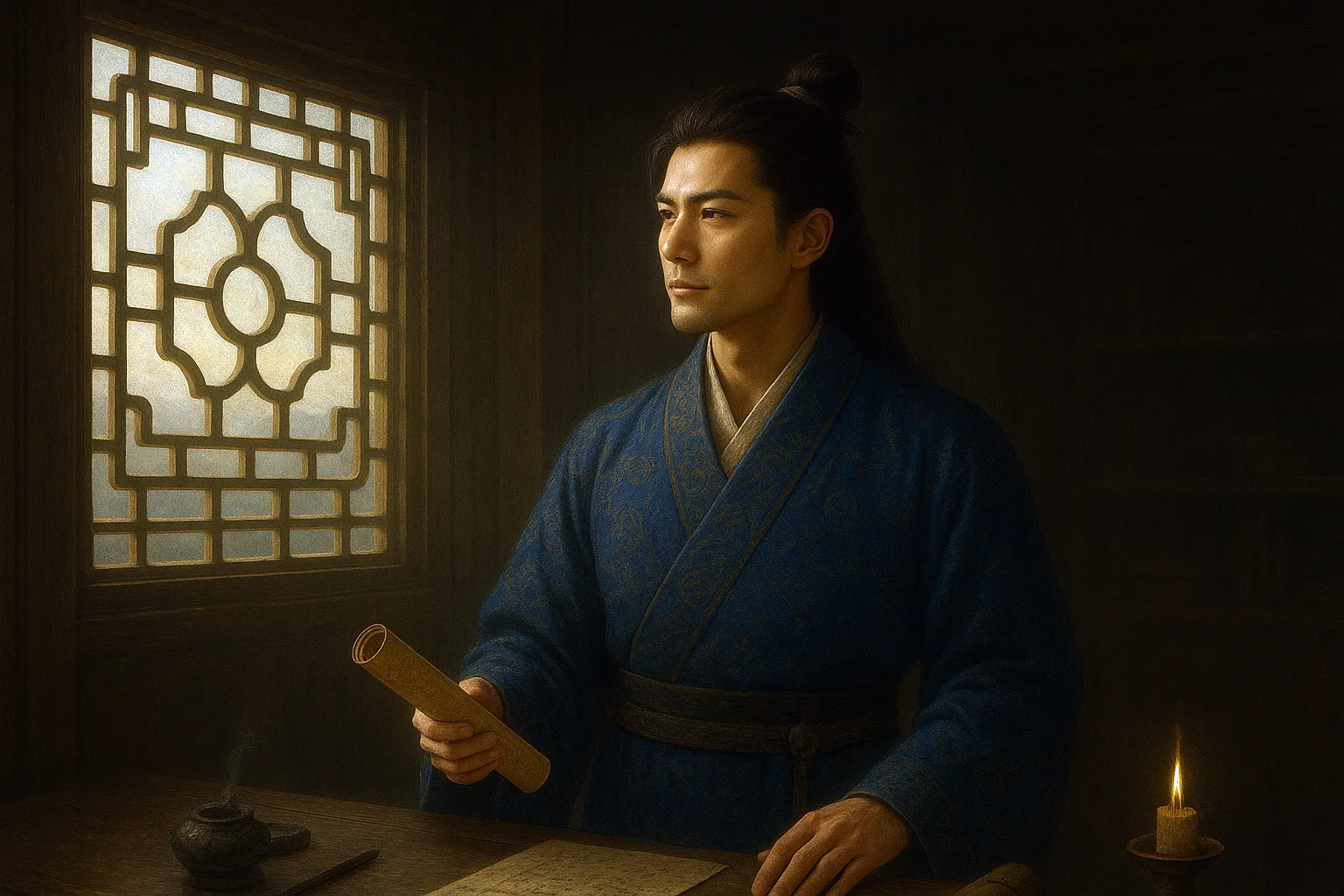
Shen Quanqi (沈佺期 c. 656–715), courtesy name Yunqing, was a native of Neihuang in Henan Province and an important poet of the early Tang Dynasty. Along with Song Zhiwen, he was renowned as one of the "Shen-Song" duo, whose work played a decisive role in finalizing the form of the five-character regulated verse (wuyan lüshi) in Tang poetry. His poems often include courtly compositions and travel-themed reflections, characterized by refined elegance and structural rigor. Shen was particularly skilled in the seven-character regulated verse (qilü), and his writing marks a transition from the lingering style of the Six Dynasties to the flourishing era of High Tang poetry. His contributions hold milestone significance in the development of modern-style verse (jintishi).






